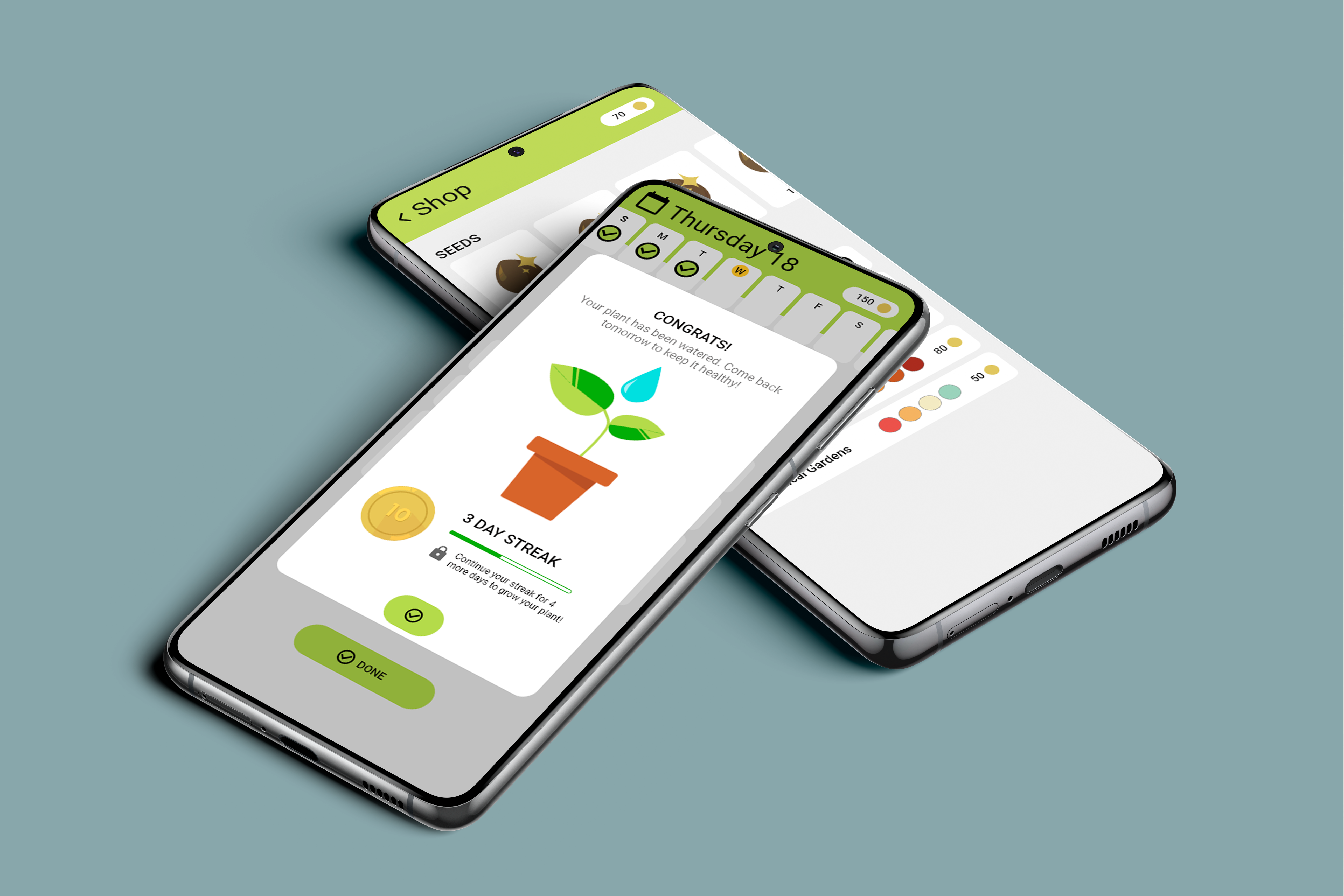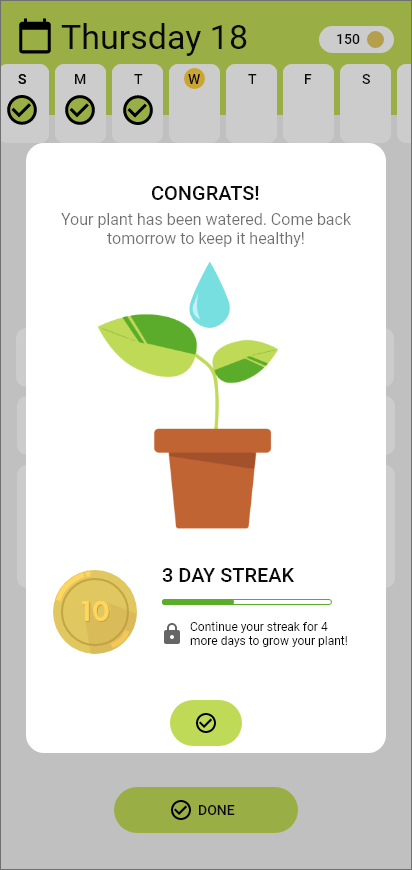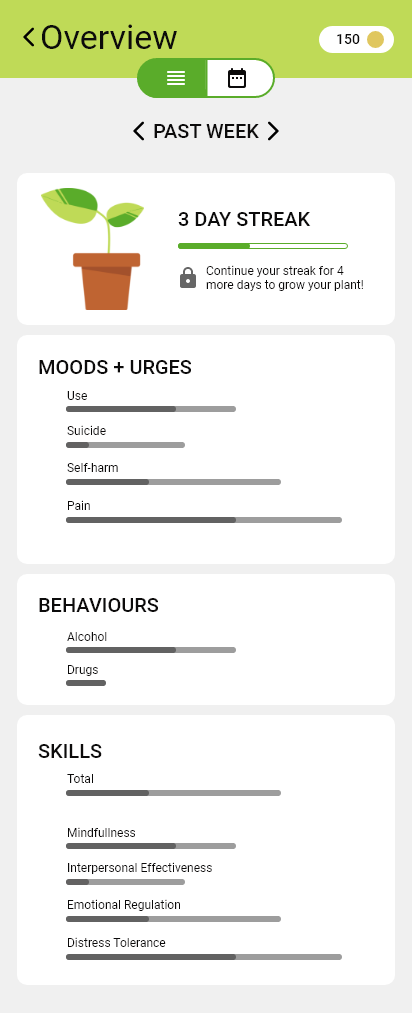UX/UI
Skills: Human centered design research, prototyping
Tools: Adobe XD, Adobe InDesign
Tools: Adobe XD, Adobe InDesign
TinyDBT
Diary cards are an important part of Dialectical Behavior Therapy (DBT), but are known to have very low patient compliance. TinyDBT both streamlines and gamifies the process of filling out a diary card. Each consecutive card completion earns coins, and waters a virtual plant. The application’s color scheme and the type of plant can be customised in the in-game store.
︎︎︎ Application walkthrough
︎︎︎ Promotional video
Diary cards are an important part of Dialectical Behavior Therapy (DBT), but are known to have very low patient compliance. TinyDBT both streamlines and gamifies the process of filling out a diary card. Each consecutive card completion earns coins, and waters a virtual plant. The application’s color scheme and the type of plant can be customised in the in-game store.
︎︎︎ Application walkthrough
︎︎︎ Promotional video


TinyDBT: Process
Overview
Therapy is an amazing tool for improving quality of life, but the responsibility for change ultimately falls on the patient. It can be difficult to apply the skills learned to everyday life. One approach to overcome this is Dialectical Behavioural Therapy’s (DBT) use of diary cards.
Therapy is an amazing tool for improving quality of life, but the responsibility for change ultimately falls on the patient. It can be difficult to apply the skills learned to everyday life. One approach to overcome this is Dialectical Behavioural Therapy’s (DBT) use of diary cards.
These paper handouts are used by patients to track their mood, skill usage, and target behaviours they are currently working on changing. These cards, however, have very low patient compliance, as they are inconvenient and tedious. TinyDBT aims to offer an alternative.
Research
Competitive Analysis
Five applications were compared on the following factors: cost, whether they were DBT based, whether they had a diary card function, whether they could link with a therapist, the number of taps required to begin filling out the diary card or equivalent, the subjective pleasure of the experience (on a scale of 0-5), and the subjective aesthetic qualities (0-5). The rating given for pleasure of experience incorporated evaluation of the internal logic of the application’s layout, the ease of use, and how functional it was.
Takeaways
Five applications were compared on the following factors: cost, whether they were DBT based, whether they had a diary card function, whether they could link with a therapist, the number of taps required to begin filling out the diary card or equivalent, the subjective pleasure of the experience (on a scale of 0-5), and the subjective aesthetic qualities (0-5). The rating given for pleasure of experience incorporated evaluation of the internal logic of the application’s layout, the ease of use, and how functional it was.
Takeaways
- The order and visual structure of the DBT diary card is not what is important, but rather the information that is obtained from it. Therefore, different ways of organising the questions and activities for maximum user engagement and enjoyment should be explored.
- Applications intended for general use rather than specifically for DBT were often better designed and easier to use. Therefore, there is a gap in the market for a high-performance app which connects patients’ data to their therapists directly.
A Day in The Life
The subject, a current DBT patient, was asked to record each time they used a DBT skill, which skills were used, and a bit about the prompting event and context over a 24 hour period. This served a dual purpose - to see what situations in daily student life might prompt the use of DBT skills, and to see the feasibility of a user recording each of these.
Takeaways
The subject, a current DBT patient, was asked to record each time they used a DBT skill, which skills were used, and a bit about the prompting event and context over a 24 hour period. This served a dual purpose - to see what situations in daily student life might prompt the use of DBT skills, and to see the feasibility of a user recording each of these.
Takeaways
- DBT skills are integrated into every aspect of life, not just crisis situations.
- Someone currently in a DBT program would likely not take much benefit from guidance on applying commonly used skills, as they are likely already quite experienced in this.
- Therefore it makes sense, due to time constraints, to narrow my focus to solely adapting DBT diary cards, rather than additional instructional or guiding content.
“5 Whys” Interview
The “5 Whys” technique was employed to learn more about why diary cards are an ineffective and frustrating task for many DBT patients. I interviewed three students, one currently in a DBT program and two who either are or have been in holistic DBT or CBT informed therapy practice. The subjects were asked why they find daily tasks difficult, annoying, or frustrating to complete. Subjects were then asked follow-up “why” questions to explore the deeper reasons for their difficulties. Finally, the approach was flipped, and subjects were asked what it was about tasks or activities they completed willingly each day, that made it engaging to do so, with similar following “why” questions.
Takeaways
The “5 Whys” technique was employed to learn more about why diary cards are an ineffective and frustrating task for many DBT patients. I interviewed three students, one currently in a DBT program and two who either are or have been in holistic DBT or CBT informed therapy practice. The subjects were asked why they find daily tasks difficult, annoying, or frustrating to complete. Subjects were then asked follow-up “why” questions to explore the deeper reasons for their difficulties. Finally, the approach was flipped, and subjects were asked what it was about tasks or activities they completed willingly each day, that made it engaging to do so, with similar following “why” questions.
Takeaways
- For any activity to draw participants back in day after day, it must provide an immediate sense of reward or pleasure.
- Activities which continually drew back the subjects, such as video games or social media, were engaging because there was often new or unexpected content. One subject expressed the importance of a sense of progression to them.
- Not remembering to do tasks if they are not highly visible presented an issue for all subjects. This informs the importance of a reminder or notification system.
Personas
I applied my research findings by creating a primary and secondary persona, representing a client and their therapist respectively. Each persona represents their current frustrations with DBT diary cards, their goals, as well as their respective skills and pain points when using digital technology.
I applied my research findings by creating a primary and secondary persona, representing a client and their therapist respectively. Each persona represents their current frustrations with DBT diary cards, their goals, as well as their respective skills and pain points when using digital technology.
Key Features
I identified the following features as crucial to the success and usefulness of TinyDBT.
I identified the following features as crucial to the success and usefulness of TinyDBT.
- Reminders system
- Multi-sensory feedback to inputs
- Rewards system which gives the feeling of accomplishment. Get users “addicted” and invested.
- Engaging visual design
- Sliders and other tactile input methods
- Ability to share data with a therapist, including converting and exporting data in a more traditional diary card format.


Design & Prototyping





Initial Wireframe
On paper, I drew out five key screens which demonstrated the main intended userflow of the app. In each major section — Moods + Urges, Behaviours, and Skills — data is input through a unique method. This serves to increase user engagement and to make the app more visually appealing. After all sections have been filled out, the user earns coins and waters their plant.
On paper, I drew out five key screens which demonstrated the main intended userflow of the app. In each major section — Moods + Urges, Behaviours, and Skills — data is input through a unique method. This serves to increase user engagement and to make the app more visually appealing. After all sections have been filled out, the user earns coins and waters their plant.
Functional Paper Prototype
For my functional paper prototype, I added screens for the shop, demonstrating how users can spend the coins they earn by filling out their diary card on new colour schemes for the app, or new plants to grow. I also experimented with one way of displaying a summary of the user’s logged data over time. In addition, I added the ability to leave a note on each day’s diary card, so that users can contextualise events and note possible triggers.
︎︎︎ Paper prototype walkthrough
For my functional paper prototype, I added screens for the shop, demonstrating how users can spend the coins they earn by filling out their diary card on new colour schemes for the app, or new plants to grow. I also experimented with one way of displaying a summary of the user’s logged data over time. In addition, I added the ability to leave a note on each day’s diary card, so that users can contextualise events and note possible triggers.
︎︎︎ Paper prototype walkthrough
Final Design







Reflection & Next Steps
With more time, I would aim to make the app more visually rich. For example, in the panel which displays summaries of a user’s logged data, colour could be added to the bars of the chart to indicate safe or dangerous levels. In addition, I could to design custom icons for each skill. This would provide a visual memory cue for each skill, and aid in differentiating between them.
With more time, I would aim to make the app more visually rich. For example, in the panel which displays summaries of a user’s logged data, colour could be added to the bars of the chart to indicate safe or dangerous levels. In addition, I could to design custom icons for each skill. This would provide a visual memory cue for each skill, and aid in differentiating between them.